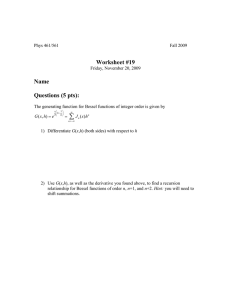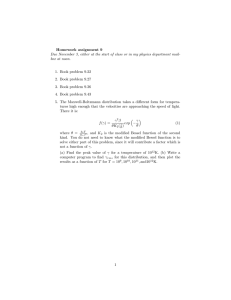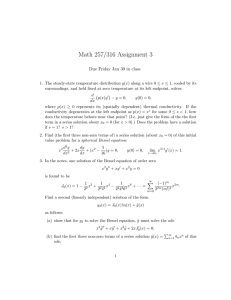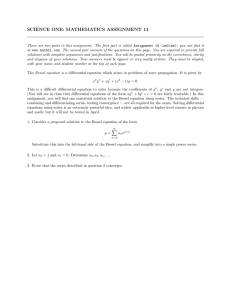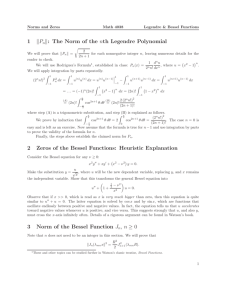EPAPS: On the origin and convergence of a Post
advertisement
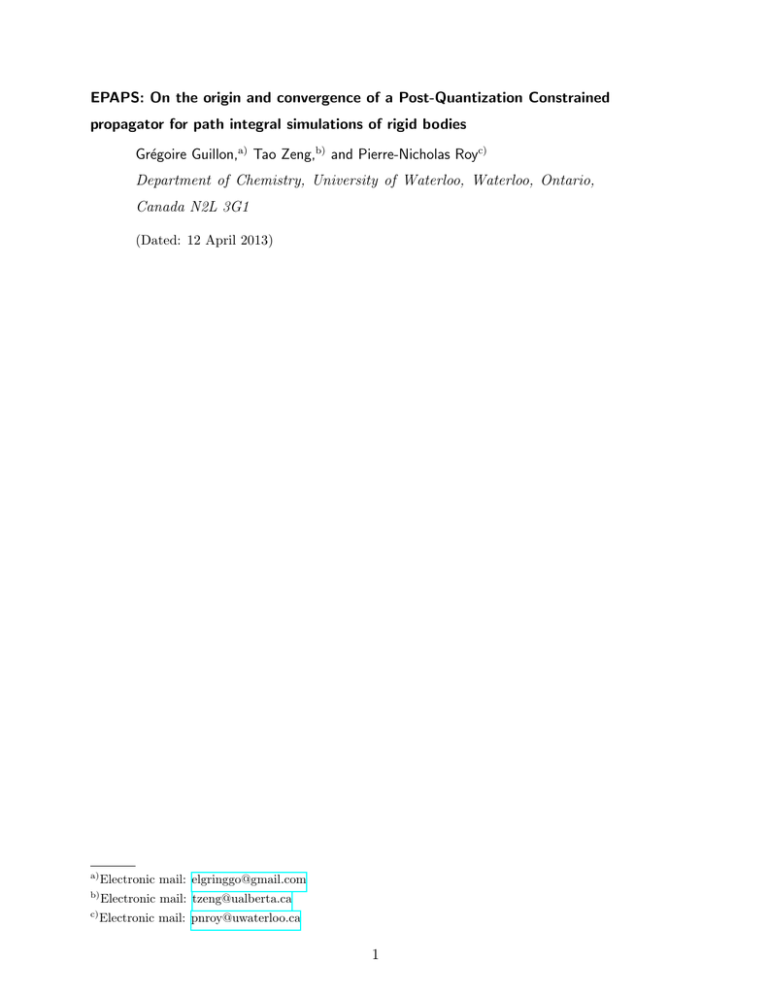
EPAPS: On the origin and convergence of a Post-Quantization Constrained
propagator for path integral simulations of rigid bodies
Grégoire Guillon,a) Tao Zeng,b) and Pierre-Nicholas Royc)
Department of Chemistry, University of Waterloo, Waterloo, Ontario,
Canada N2L 3G1
(Dated: 12 April 2013)
a)
Electronic mail: elgringgo@gmail.com
b)
Electronic mail: tzeng@ualberta.ca
c)
Electronic mail: pnroy@uwaterloo.ca
1
I.
2D-DENSITY MATRIX IN TERMS OF CYLINDRICAL BESSEL
FUNCTIONS
Essential arguments of a purely geometric nature (see Section II) motivate quite naturally
the expansion of the Euclidean 2D-density matrix in terms of Bessel functions. A plane wave
(p-basis) in R2 is ordinarily expanded in imaginary exponentials (m-basis), the expansion
coefficients being Bessel functions of the first kind, Jm (z).1–3 However, the exponential in our
density matrix has a real argument, so these are replaced by imaginary argument (also called
”modified”) Bessel functions Im (z). Equation (6) from the main article then automatically
becomes:
ρ2D (r0 , r; τ ) = hr0 | e−τ H2D | ri
= λ−2
τ e
=
−
π
λ2
τ
(r02 +r2 ) −
e
π
λ2
τ
rr0 cos ∆φ
∞
X
− π2 (r02 +r2 )
λτ
λ−2
τ e
Im
m=−∞
2π 0 im∆φ
rr e
λ2τ
(1)
The radial thermal amplitudes, r0 | e−H2D | r m , have been shown to be properly defined
by the relation4–6 (see for example, Eq. (4.38) of ref. 5):
ρ2D (r0 , r; τ ) = hr0 | e−τ H2D | ri
≡
≡
∞
X
1
√
2π rr0
2π
1
√
rr0
m=−∞
∞
X
r0 | e−H2D | r
m
eim∆φ
ρ(r0 , r; τ )m eim∆φ
(2)
m=−∞
Finally, the one-slice τ radial amplitudes are found to be
2π √
− π (r2 +r02 )
ρ(r , r; τ )m = 2 rr0 e λτ 2
Im
λτ
0
2π 0
rr
λτ 2
(3)
which is also valid by using convolution property of Bessel functions3,6 for finite β.
If we apply brutally the PQC approximation to this expression, we expect to find a zero
amplitude for radial motion. However, we find:
ρ(re , re ; τ )m =
1
1
e− 2Be τ Im (1/2Be τ )
2Be re τ
for any τ , which is seen to be finite and nonzero in general.
2
(4)
Nevertheless, we can now look at the asymptotic τ −→ 0 limit, which may be obtained
with the asymptotic form of the modified Bessel functions Im (z) for τ −→ 0, that is, z −→ ∞
N
ez X
1
Im (z) ∼ √
(−)k (m, k)
2πz k=0
(2z)k
(5)
where
(m, k) =
(4m2 − 12 )(4m2 − 32 ) . . . (4m2 − (2k − 1)2 )
22k k!
and
(m, 0) = 1
and where the (divergent when N → ∞) series appearing is the so-called asymptotic develp
opment of ( (2πz)/ez )Im (z).2,3 If we keep only the first term of the asymptotic expansion,
we obtain for Eq. (3)
−
0
asymp.
ρ(r , r; τ )m −−−−→
e
π
(r0 −r)2
λτ 2
λτ
τ →0
m2 − 1/4 λτ 2
1−
+ ···
4π
rr0
(6)
This expression of the radial amplitude tends to 0 as τ −→ 0, as we expect based on physical
arguments. However, setting r = r0 = re in this expression, causes its sudden divergence for
small τ ,
1
m2 − 1/4 λτ 2
ρ(re , re ; τ )m −−−−→
1−
+ ···
τ →0
λτ
4π
re2
asymp.
(7)
so the limit of the PQC radial amplitude is singular. This is a manifestation of the fact that
no radial amplitude can exist for the true propagator on the ring.
In R3 the radial thermal amplitudes are given by the expression:4–6
∞
`
1 X X 0 −H3D ∗
r |e
| r l Y`m (θ0 , φ0 )Y`m
(θ, φ)
ρ3D (r0 , r; τ ) ≡ r0 | e−H3D | r = 0
rr `=0 m=−`
∞
`
1 X X
∗
= 0
ρ(r0 , r; τ )l Y`m (θ0 , φ0 )Y`m
(θ, φ)
rr `=0 m=−`
(8)
Homogeneity and isotropy of space allow us to invoke group-theoretical arguments to
expand the ”plane wave” exponential appearing in the PQC density matrix expression.
The group of motion in R3 is the Euclidean group E3 , which has six generators (three for
translations and three for rotations) and two Casimir operators. Without entering into any
details, the representation functions are now spherical (half-odd integers) Bessel functions
3
(instead of cylindrical ones as for E2 . The exponential is thus expanded as:
−
ρ3D (r0 , r; τ ) = hr0 | e−H3D | ri = λ−3
τ e
π
λ2
τ
∞ X
`
X
(r02 +r2 ) −
e
π
λ2
τ
rr0 cos Θ
4π 0
∗
(θ, φ)
(9)
=
ı̂`
rr Y`m (θ0 , φ0 )Y`m
2
λ
τ
`=0 m=−`
pπ
where the spherical imaginary argument Bessel functions are defined as ı̂` (z) = 2z
I`+1/2 (z).
− π2 (r02 +r2 )
λτ
e
4πλ−3
τ
The asymptotic limit of these spherical Bessel functions, which appear in the expression of
the radial thermal amplitudes in 3D-space, following a completely similar scheme as exposed
in Sec. II for 2D-space, or, alternatively, the usual separation of variable procedure of
the Schrödinger equation in spherical polar coordinates, gives rises to the very well known
centrifugal potential:
Veff =
II.
~2 `(` + 1)
2µr2
(10)
GROUP-THEORETICAL BASED SYMMETRY CONSIDERATIONS
FOR THE PROPAGATOR IN TWO SPACE DIMENSIONS
In order to justify Eq. (1), as well as to gain as much insight as possible on the essential
geometric nature of the problem, we note that the largest symmetry group acting on the
Euclidean plane R2 is the Euclidean group E2 , also called the group of motions in the
plane. This group consists of all continuous linear transformations on the two-dimensional
Euclidean plane R2 which leave the length of all vectors unchanged. It is not hard to
see that these transformations can only be combinations of translations, parametrized by
a vector b of length b and orientation φ and rotations parametrized by the sole angle θ.
In this way, any object living in the plane can be translated in any direction (b, φ) and
rotated on itself by θ. A generic element of the group can be written as g(b, θ) = t(b)r(θ)
where t(b) = g(b, 0) corresponds to a pure translation and r(θ) = g(0, θ) corresponds to
a pure rotation. Of course, the set of pure rotations as well as that of pure translations in
any direction constitute both Abelian subgroups of E2 . More than that, the subgroup of
translations, T2 , is an invariant one, so the factor group E2 /T2 can be constructed, and
shown to be isomorphic to SO(2). The ’m’ labels for the representations of SO(2) (that
is the angular momentum quantum numbers for the unnormalized ’particle on a ring’ basis
functions eimφ , m = ..., −1, 0, 1, ... ) enter naturally in this way for the classification of the
degenerate representations (induced by that of the factor group) of the full group E2 .
4
The associated Lie algebra, e2 , has a basis of three generators, namely two ”linear momenta” p̂x and p̂y along directions x and y, (having the unit of inverse length) plus one
”angular momentum” ĵ for rotations in the plane (dimensionless). They obey, evidently
enough, the commutation relations [p̂x , p̂y ] = 0 (any two translations must always commute)
and [ĵ, p̂α ] = i~αβ p̂β with Einstein summation convention and α, β = x, y, αβ beeing the
permutation symbol in 2D-space.
The elements of the two subgroups described above, by the usual exponentiation of the
generators, now take the form t(b) = e−ibp̂ and r(θ) = e−iθĵ , where p̂ = (p̂x , p̂y ). These
generators can be combined in the usual way, by forming p̂± = p̂x ± ip̂y in order to get a
’squared momentum’, p̂2 = p̂2x + p̂2y = p̂+ p̂− = p̂− p̂+ which is a Casimir operator, satisfying
the commutation relations [p̂2 , ĵ] = [p̂2 , p̂± ] = 0, and having the same unique eigenvalue for
each irreducible representation of E2 , and thus very useful to construct a basis formed by
its eigenvectors:
p̂2 | p mi = p2 | p mi
(11)
ĵ | p mi = m | p mi
(12)
with p2 positive. Similarly as in ordinary angular momentum algebra, p̂± | p mi, whose
p
norm is p2 = p, is an eigenstate of ĵ with eigenvalue m ± 1. Each vector so generated is
defined, in the active point of view for transformations, as | p m ± 1i ≡ ± pi p̂± | p mi to be
consistent with the usual Condon and Shortley phase convention7,8
As for any system of a two-dimensional nature, the elements of representation matrices
for finite transformations under E2 are given by usual (cylindrical) Bessel functions of the
first kind1,2 (multiplied by oscillating imaginary exponential functions), that mix radial
and angular components of motions. The group E2 beeing non compact, the space for the
representation is of infinite dimension. The entire infinite basis {| p mim = 0, ±1, ±2, ...; p ∈
R+ } can be constructed by successive applications of the previously defined ladder operators
p̂± , starting from an arbitrary standard vector in the representation space. In this basis,
which we shall call the ’angular momentum’ basis, the representation matrices for finite
transformations are found to be
0
Dp (b, θ)m0 m = hp m0 | g(b, θ) | p mi = ei(m−m )φ Jm−m0 (pb)e−imθ
(13)
We now need to construct another basis, which is the basis for the irreducible space
consisting of eigenvectors of p̂, the so-called ’plane wave basis’, and make the connexion
5
with the ’angular momentum’ basis. As it appears, p̂ is a generator of T2 , invariant Abelian
subgroup of E2 . It is thus natural to apply the Frobenius induced representation method
(see a standard text on Group Theory, such as Ref. 9 or Ref. 7) to generate the p-labelled
irreducible representations of E2 . Starting from a ’standard’ geometric vector p? = (p, 0)
with associated ket | p? i such as p̂x | p? i = p | p? i and p̂2 | p? i = p2 | p? i, we can
define | pi ≡ r(θ) | p? i such that p = (p, θ) and t(b) | pi = e−ib.p | pi. The set {| pi}
constitutes a basis for the irreducible invariant space under the action of E2 , whose elements
are normalized by hp0 | pi = hp0 θ0 | p θi = 2πδ(θ0 − θ).
We can now establish the relationship between the m- and p-bases. Since | p mi is an
eigenvector of ĵ, it can be obtained from any ’standard’ vector | p m? i of the m-representation
space. Choosing
2π
Z
?
Z
dφ imφ
e r(φ) | p? i =
2π
| pm i =
0
2π
0
dφ imφ
e
| p φi
2π
(14)
we see that r(θ) | p m? i = e−imθ | p m? i and thus | p m? i is proportinal to | p mi. With our
phase convention, | p m? i = im | p mi, so hpφ | pmi = im eimφ . As a result, | p φi can be
expanded as
| p φi =
+∞
X
i−m e−imφ | p mi
(15)
m=−∞
Acting on the left with hm0 | t(b) we obtain taking b = (b, α)
−ipb cos(α−φ)
e
+∞
X
0
hm | φi =
| {z }
e−im0 φ
m=−∞
i−m e−imφ hm0 | t(b) | mi
|
{z
}
ei(m−m
0 )α
(16)
Jm−m0 (pb)
So, at last,
−ipb cos(α−φ)
e
+∞
X
=
0
i−m ei(m−m )[α−φ] Jm−m0 (pb)
(17)
m=−∞
Setting m0 = 0 and redefining α − φ = ∆φ, we have
−ipb cos ∆φ
e
=
+∞
X
i−m eim∆φ Jm (pb)
(18)
m=−∞
With −ipb =
2π
rr0
λ2τ
and replacing the cylindrical Bessel function Jm (z) by the modified one
Im (z) ≡ i−m Jm (iz), we find the expansion used in Eq. (1).
Note that Eq. (1) could have been obtained through a Laurent expansion of the generating
function of Bessel functions; however, we feel that this more analytical way of obtaining this
6
result is less likely to underline the very geometric nature of the problem. Also, all results
obtained in R2 with the help of the group E2 could have been obtained by starting the whole
analysis in R3 directly by group contraction of SO(3), the group of pure rotations in 3Dspace, whose representation functions are the very-well known Wigner d-functions djm,m0 (z)
(also proportional to Jacobi polynomials3 ) into E2 , by taking the asymptotic limit:
asymp.
Jm (z) −−−−→ dj−m,0 (z/j)
(19)
j→∞
However, the approah used above, that is, exploiting the maximum of symmetry in two
dimensions, highlights more the nature of the problem and avoids the unnecessary fact of
an overall embedding 3D-space when studying physical phenomena.
III.
m-BASIS MATRIX ELEMENTS FOR THE PQC PROPAGATOR OF
A PARTICLE ON A RING
For the particle on a ring problem, we have seen that the density operator can be written
as:
ρ̂P QC
with ρP QC (φ0 , φ; τ ) =
H
H
= du du0 | u0 iρP QC (u0 , u; τ )hu |
R 2π
R 2π
= 0 dφ 0 dφ0 | φ0 iρP QC (φ0 , φ; τ )hφ |
e−a a cos ∆φ
e
,
2π
a =
1
.
2Be τ
(20)
The matrix elements in the {| mi ; m =
0, ±1, ±2, . . .} basis then read:
hm | ρ̂P QC
e−a
|mi= 2
4π
Z
−a
Z
0
e
= 2
4π
e−a
= 2
4π
=e
=
−a
2π
Z
2π
0
0
0
0
dφ0 e−imφ eim φ ea cos(φ −φ)
dφ
0
2π
Z
dφ
0
2π
dφ e
m”=−∞
δmm0 e−a Im
0
Im” (a) eim”(φ −φ)
m”=−∞
Z
Im” (a)
2π
dφe
im0 φ −im”φ
0
m”=−∞
+∞
X
e
0
+∞
X
+∞
X
0 −imφ0 im0 φ
e
Z
×
2π
0
dφ0 eim”φ e−imφ
0
0
Im” (a) δm0 m” δm”m
(a)
(21)
7
IV.
CENTRIFUGAL TERM APPEARING IN THE ACTION FOR
CYLINDRICAL SYMMETRY (2D-MOTION)
Let’s consider the concrete example of a charged particle (of charge e) in magnetic field
H along the z-axis. The time-independent Schrödinger equation in cylindrical coordinates
(r, φ, z) for this particle (see for example, ex. 8 of chap. 6 of Ref. 10) reads (in CGS units):
1 ∂ 2Ψ
ie~ ∂Ψ e2 H2 2
~2 ∂ 2 Ψ ∂ 2 Ψ 1 ∂Ψ
+ 2 2 −
H
+
+
+
r Ψ = EΨ
(22)
−
2µ ∂z 2
∂r2
r ∂r
r ∂φ
2µc ∂φ
8µc2
where c is the velocity of light in vaccuum.
Symmetry considerations, amply discussed in Section II, suggest solutions of the form:
Ψ(r, φ, z) = p
1
R(r)Z(z)Φ(φ) = p
R(r)eikz z eimφ
(2π)
(2π)
1
(23)
Injecting this expression for Ψ in the Schrödinger equation, and dividing by Ψ, assuming
that Ψ 6= 0 (which is the usual separation procedure) we obtain the radial equation
m2
1 0
2 2
00
R + R + β − γ r − 2γm − 2 = 0
r
r
with β =
2µE
~2
− kz2 and γ =
eH
.
2c~
By doing the simple change of function u =
√
rR, we are immediatly led to
(1/4 − m2 )
u + −γ r +
+ (β − 2γm) u = 0
r2
00
(24)
2 2
(25)
Finally, putting the field H = 0, we obtain
~2 00
~2
~2 2
2
(m
−
1/4)u
+
u +
k u = Eu
2µ
2µr2
2µ z
with Veff (r) =
~2
(m2
2µr2
(26)
− 1/4). Only in the semi-classical approximation (which is an a
asymp.
asymptotic limit in nature) do we have m2 − 1/4 −−−−→ m2 .
m→∞
V.
(`, m)-BASIS MATRIX ELEMENTS FOR THE LINEAR ROTOR PQC
PROPAGATOR
From the definition of the linear rotor PQC propagator,
I
I
ρ̂P QC = du du0 | uiρP QC (u, u0 ; τ )hu0 |
8
(27)
we have in the basis {| ` mi ; ` = 0, 1, . . . m = −`, . . . , +`} the (`, m)-basis matrix elements
I
I
0
0
∗
h` m | ρ̂P QC | ` m i = du du0 Y`m
(u)ρP QC (u, u0 ; τ )Y`0 m0 (u0 )
I
I
e−a
∗
=
du du0 Y`m
(u)eax Y`0 m0 (u0 )
(28)
4π
with ρP QC (u0 , u; τ ) =
e−a ax
e ,
4π
1
2Be τ
a =
d
and x = cos Θ, Θ = u,
u0 with u = (θ, φ) and
u0 = (θ0 , φ0 ). We can expand
ax
e
=
∞
X
cλ Pλ (x) ,
(29)
λ=0
and obtain
h` m | ρ̂P QC
I
I
∞
e−a X
∗
cλ du du0 Y`m
(u)Pλ (x)Y`0 m0 (u0 )
|` mi=
4π λ=0
0
0
(30)
But according to the spherical harmonics addition theorem7,11
λ
X
Pλ (x) = Pλ (u.u0 ) =
(−)q Cλ q (u)Cλ −q (u0 )
(31)
q=−λ
with Cλ q (u) =
q
4π
Y (u)
2λ+1 λ q
0
Kλ`m` m
0
is a reduced spherical harmonic. Then,
I
I
∗
≡ du du0 Y`m
(u)Pλ (x)Y`0 m0 (u0 )
=
λ
X
q
I
I
(−)
du
∗
du0 Y`m
(u)Cλ q (u)Y`0 m0 (u0 )Cλ −q (u0 )
(32)
q=−λ
This reduces to
`m`0 m0
Kλ
=
λ
X
r
(−)
q
q=−λ
4π
2λ + 1
r
I
∗
duY`m
(u)Yλq (u)
{z
|
Then
0 0
Kλ`m` m
4π
2λ + 1
}
=δ`λ δmq
I
∗
du0 Y`0 m0 (u0 )(−)q Yλq
(u0 ) (33)
{z
}
|
=(−)q δ`0 λ δm0 q
λ
λ
4π X
4π X
=
δ`λ δ`0 λ δmq δm0 q = δmm0 δ`λ δ`0 λ
δmq
2λ + 1 q=−λ
2λ + 1 q=−λ
(34)
So
h` m | ρP QC
∞
e−a X
0 0
|` mi=
cλ Kλ i`m` m
4π λ=0
0
0
= δmm0 e−a
∞
X
λ=0
−a
= δmm0 δ``0 e
λ
X
cλ
δ`λ δ`0 λ
δmq
2λ + 1
q=−λ
∞
X
λ=0
9
λ
X
cλ
δ`λ
δmq
2λ + 1 q=−λ
(35)
At this point, we see that the PQC density matrix is diagonal in the quantum numbers `
and m, exactly as the exact one. Let us now evaluate the diagonal elements.
−a
h` m | ρP QC | ` mi= e
∞
X
λ=0
λ
X
cλ
δ`λ
δmq
2λ + 1 q=−λ
(36)
We easily see that the sum over q is
λ
X
q=−λ
δmq =
1 if | m |≤ λ
0 if | m |> λ .
But λ takes on every value up to ∞, so finally
h` m | ρP QC | ` mi = e−a
c`
,
2` + 1
(37)
with
1
c` = (` + )
2
Z
1
eax P` (x)dx ,
(38)
−1
with x = cos Θ. Hence the expression given in the text.
REFERENCES
1
G. N. Watson, a Treatise on the Theory of Bessel Functions, Cambridge University Press;
second edition, 1995.
2
N. N. Lebedev, special Functions and their Applications, Dover Publications, New York,
1972.
3
M. Abramowitz and I. A. Stegun, handbook of Mathematical Functions: with Formulas,
Graphs, and Mathematical Tables, Dover Publications, New York, 1965.
4
R. G. Storer, J. Chem. Phys. 9, 964 (1968).
5
D. M. Ceperley, Rev. Mod. Phys. 67, 279 (1995).
6
H. Kleinert, path Integrals in Quantum Mechanics, Statistics, Polymer Physics, and Financial Markets,World Scientific Publishing Company; fifth edition, Sinagapore, 2009.
7
W.-K. Tung, group Theory in Physics, World Scientific Publishing Company, Singapore,
1985.
8
E. U. Condon and G. H. Shortley, the Theory of Atomic Spectra, Cambridge University
Press, 1953.
10
9
M. Hamermesh, group Theory and its Application to Physical Problems, Dover Publications, New York, 1989.
10
I. I. Goldman and V. D. Krivchenkov, problems in Quantum Mechanics, Dover Publications, New York, 1993.
11
D. M. Brink and G. R. Satchler, angular Momentum, 3rd ed., Clarendon Press, Oxford
Science Publications, 1993.
11
